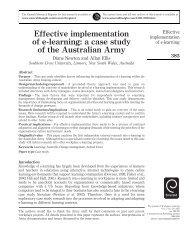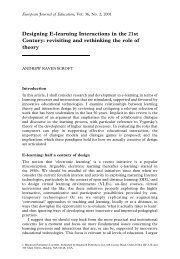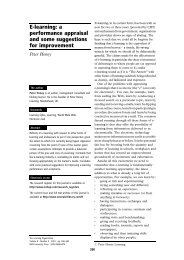E-Learning: strategies for delivering knowledge in the digital age
E-Learning: strategies for delivering knowledge in the digital age
E-Learning: strategies for delivering knowledge in the digital age
You also want an ePaper? Increase the reach of your titles
YUMPU automatically turns print PDFs into web optimized ePapers that Google loves.
Internet and Higher Education<br />
5 (2002) 185–188<br />
Book review<br />
E-<strong>Learn<strong>in</strong>g</strong>: <strong>strategies</strong> <strong>for</strong> <strong>deliver<strong>in</strong>g</strong> <strong>knowledge</strong><br />
<strong>in</strong> <strong>the</strong> <strong>digital</strong> <strong>age</strong><br />
Paula Elizabeth Sanderson*<br />
E-<strong>Learn<strong>in</strong>g</strong> and Consult<strong>in</strong>g Philips Medical Systems North America<br />
70 Pilgrim Road, Torr<strong>in</strong>gton, CT 06790, USA<br />
Received 21 October 2001<br />
Marc J. Rosenberg (2001). New York, NY: McGraw-Hill Companies, Inc., 343 p<strong>age</strong>s,<br />
ISBN: 0-07-136268-1. US$29.95<br />
1. Overview<br />
Marc J. Rosenberg’s book titled E-<strong>Learn<strong>in</strong>g</strong>: Strategies <strong>for</strong> Deliver<strong>in</strong>g Knowledge <strong>in</strong> <strong>the</strong><br />
Digital Age is a high-level, enterprise-wide strategic approach to e-learn<strong>in</strong>g <strong>in</strong> today’s<br />
organizations. Although focused on corporate organizations, <strong>the</strong> concepts and strategic tools<br />
presented <strong>in</strong> this book are applicable and appropriate <strong>for</strong> any type of organization. Organizations<br />
desirous to <strong>in</strong>vestigate <strong>the</strong> benefits of build<strong>in</strong>g a ‘‘learn<strong>in</strong>g architecture’’ (p. 33) and to<br />
understand why e-learn<strong>in</strong>g needs to be an <strong>in</strong>tegral part of this architecture, will benefit from <strong>the</strong><br />
<strong>in</strong><strong>for</strong>mation <strong>in</strong> this book.<br />
The organization of this book is focused on three global <strong>the</strong>mes:<br />
<br />
<br />
<br />
‘‘The Opportunity’’ (p. 3) is <strong>the</strong> basis <strong>for</strong> comprehend<strong>in</strong>g <strong>the</strong> current learn<strong>in</strong>g environment<br />
<strong>in</strong> most organizations and <strong>the</strong> dramatic changes <strong>in</strong> <strong>the</strong> bus<strong>in</strong>ess environment, which<br />
contribute to <strong>the</strong> competitive requirement to become a learn<strong>in</strong>g organization.<br />
‘‘New Approaches <strong>for</strong> E-<strong>Learn<strong>in</strong>g</strong>’’ (p. 41) discusses <strong>the</strong> history of e-learn<strong>in</strong>g and <strong>the</strong><br />
need to change current approaches by implement<strong>in</strong>g an <strong>in</strong>tegrated learn<strong>in</strong>g strategy that<br />
encompasses <strong>in</strong>struction, <strong>knowledge</strong> man<strong>age</strong>ment, and per<strong>for</strong>mance support.<br />
‘‘Organizational Requirements <strong>for</strong> E-<strong>Learn<strong>in</strong>g</strong>’’ (p. 151) is <strong>the</strong> ‘how to’ section that<br />
demonstrates <strong>the</strong> critical success factors to implement<strong>in</strong>g e-learn<strong>in</strong>g and effective<br />
<strong>strategies</strong> to elim<strong>in</strong>ate <strong>the</strong> barriers to e-learn<strong>in</strong>g success.<br />
* Tel.: +1-800-722-7900x4523; fax: +1-860-489-0930.<br />
E-mail address: paula.sanderson@philips.com (P.E. Sanderson).<br />
1096-7516/02/$ – see front matter D 2002 Elsevier Science Inc. All rights reserved.<br />
PII: S1096-7516(02)00082-9
186<br />
Book review<br />
Each major concept is clarified and demonstrated with case studies and ‘‘E-<strong>Learn<strong>in</strong>g</strong><br />
Journeys’’ (p. 35) from companies such as AT&T, Cisco, IBM, Dell Computers, and o<strong>the</strong>rs<br />
that understand <strong>the</strong> importance of becom<strong>in</strong>g learn<strong>in</strong>g organizations and how <strong>the</strong>y are<br />
accomplish<strong>in</strong>g this goal.<br />
2. ‘‘The opportunity’’<br />
Rosenberg def<strong>in</strong>es learn<strong>in</strong>g as ‘‘<strong>the</strong> process by which people acquire new skills or<br />
<strong>knowledge</strong> <strong>for</strong> <strong>the</strong> purpose of enhanc<strong>in</strong>g <strong>the</strong>ir per<strong>for</strong>mance’’ (p. 4). He expla<strong>in</strong>s that <strong>the</strong><br />
perceptions of learn<strong>in</strong>g <strong>in</strong> organizations are undergo<strong>in</strong>g a dist<strong>in</strong>ct trans<strong>for</strong>mation. First,<br />
tra<strong>in</strong><strong>in</strong>g should no longer only focus on <strong>the</strong> act of tra<strong>in</strong><strong>in</strong>g but must demonstrate a positive<br />
impact on per<strong>for</strong>mance or outcomes. Widely dispersed employees are demand<strong>in</strong>g access to<br />
learn<strong>in</strong>g anytime and anywhere and on <strong>the</strong>ir terms. There is a migration of <strong>in</strong><strong>for</strong>mation to <strong>the</strong><br />
onl<strong>in</strong>e environment, which can be updated cont<strong>in</strong>uously. Although classroom learn<strong>in</strong>g<br />
cont<strong>in</strong>ues to have a strong role, more people are com<strong>in</strong>g toge<strong>the</strong>r <strong>in</strong> <strong>digital</strong> classrooms.<br />
Lastly, <strong>the</strong>re is grow<strong>in</strong>g recognition that learn<strong>in</strong>g is a cont<strong>in</strong>uous, life-long process.<br />
Rosenberg def<strong>in</strong>es e-learn<strong>in</strong>g as a networked phenomenon allow<strong>in</strong>g <strong>for</strong> <strong>in</strong>stant revisions<br />
and distribution. In addition, it is delivered us<strong>in</strong>g standard Internet technology. E-learn<strong>in</strong>g<br />
goes beyond tra<strong>in</strong><strong>in</strong>g and <strong>in</strong>struction to <strong>the</strong> delivery of <strong>in</strong><strong>for</strong>mation and tools to improve<br />
per<strong>for</strong>mance. The benefits of e-learn<strong>in</strong>g are many <strong>in</strong>clud<strong>in</strong>g cost-effectiveness, enhanced<br />
responsiveness to change, consistency, timely content, flexible accessibility, and provid<strong>in</strong>g<br />
customer value. The discussion emphasizes <strong>the</strong> need <strong>for</strong> organizations to build a strategic<br />
foundation <strong>for</strong> e-learn<strong>in</strong>g, address<strong>in</strong>g <strong>the</strong> emerg<strong>in</strong>g approaches to e-learn<strong>in</strong>g <strong>in</strong> addition to<br />
syn<strong>the</strong>siz<strong>in</strong>g o<strong>the</strong>r learn<strong>in</strong>g ef<strong>for</strong>ts of <strong>the</strong> organization.<br />
3. ‘‘New approaches <strong>for</strong> e-learn<strong>in</strong>g’’<br />
Access to <strong>in</strong><strong>for</strong>mation is as essential <strong>for</strong> learn<strong>in</strong>g as <strong>in</strong>struction. Accord<strong>in</strong>g to Rosenberg,<br />
‘‘<strong>knowledge</strong> man<strong>age</strong>ment supports <strong>the</strong> creation, archiv<strong>in</strong>g, and shar<strong>in</strong>g of valued <strong>in</strong><strong>for</strong>mation,<br />
expertise, and <strong>in</strong>sight with<strong>in</strong> and across communities of people and organizations with similar<br />
<strong>in</strong>terests and needs’’ (p. 66). The benefits <strong>in</strong>clude <strong>the</strong> facilitation of learn<strong>in</strong>g with specific<br />
<strong>in</strong><strong>for</strong>mation needed at a specific time <strong>for</strong> a specific purpose and <strong>the</strong> ability to lever<strong>age</strong> and<br />
grow <strong>the</strong> collective <strong>knowledge</strong> of <strong>the</strong> organization. An important component is <strong>the</strong> <strong>in</strong>clusion<br />
of per<strong>for</strong>mance support components designed to enhance per<strong>for</strong>mance. Rosenberg stresses<br />
<strong>the</strong> research on <strong>the</strong> importance of us<strong>in</strong>g communities of <strong>in</strong>terest to support and enhance <strong>the</strong><br />
learn<strong>in</strong>g process. He emphasizes that people learn more effectively when <strong>the</strong>y <strong>in</strong>teract and are<br />
<strong>in</strong>volved with o<strong>the</strong>r people participat<strong>in</strong>g <strong>in</strong> similar endeavors. E-learn<strong>in</strong>g is powerful when<br />
both tra<strong>in</strong><strong>in</strong>g and <strong>knowledge</strong> man<strong>age</strong>ment are <strong>in</strong>tegrated, but even more powerful when<br />
<strong>in</strong>tegrated with classroom tra<strong>in</strong><strong>in</strong>g <strong>in</strong> a ‘‘learn<strong>in</strong>g architecture’’ (p. 117). He def<strong>in</strong>es a learn<strong>in</strong>g<br />
architecture as ‘‘<strong>the</strong> design, sequenc<strong>in</strong>g, and <strong>in</strong>tegration of all electronic and non-electronic<br />
components of learn<strong>in</strong>g to derive optimum improvement <strong>in</strong> competence and per<strong>for</strong>mance’’
Book review 187<br />
(p. 118). E-learn<strong>in</strong>g is not <strong>the</strong> end to classroom tra<strong>in</strong><strong>in</strong>g and, <strong>in</strong> fact, classroom tra<strong>in</strong><strong>in</strong>g will<br />
be redef<strong>in</strong>ed to focus on those aspects of learn<strong>in</strong>g that are best accomplished when <strong>the</strong>re is <strong>the</strong><br />
requirement <strong>for</strong> person-to-person <strong>in</strong>teractions, identify<strong>in</strong>g opportunities <strong>for</strong> improvement,<br />
team ef<strong>for</strong>ts, evaluative tasks, and <strong>the</strong> participation of experts with <strong>the</strong> group.<br />
4. ‘‘Organizational requirements <strong>for</strong> e-learn<strong>in</strong>g’’<br />
Rosenberg discusses <strong>the</strong> <strong>in</strong>frastructure and technology considerations <strong>for</strong> succeed<strong>in</strong>g <strong>in</strong><br />
e-learn<strong>in</strong>g. Any e-learn<strong>in</strong>g strategy is doomed to failure without adequate access to <strong>the</strong><br />
Internet. In addition, <strong>the</strong> level or speed of connectivity and <strong>the</strong> learn<strong>in</strong>g plat<strong>for</strong>m to be used<br />
must be considered. The learn<strong>in</strong>g man<strong>age</strong>ment system (LMS) is ano<strong>the</strong>r consideration and<br />
is essential to allow employees and employers to man<strong>age</strong> and evaluate <strong>the</strong> learn<strong>in</strong>g process.<br />
An important part of this section is <strong>the</strong> discussion on <strong>the</strong> critical success factors that must<br />
be considered when embark<strong>in</strong>g on <strong>the</strong> e-learn<strong>in</strong>g path. These factors are ‘‘culture, champions,<br />
communication, and change’’ (p. 179). ‘‘Organizations that are truly learn<strong>in</strong>g organizations,<br />
quickly move beyond <strong>the</strong> where and how of learn<strong>in</strong>g, concentrat<strong>in</strong>g <strong>in</strong>stead on <strong>in</strong>gra<strong>in</strong><strong>in</strong>g it<br />
<strong>in</strong>to <strong>the</strong> work culture’’ (p. 180). Rosenberg articulates how each of <strong>the</strong>se factors can help or<br />
h<strong>in</strong>der an e-learn<strong>in</strong>g <strong>in</strong>itiative and gives valuable <strong>strategies</strong> <strong>for</strong> success. For example, culturebuild<strong>in</strong>g<br />
<strong>strategies</strong> that work <strong>in</strong>cludes mak<strong>in</strong>g man<strong>age</strong>rs accountable <strong>for</strong> <strong>the</strong> learn<strong>in</strong>g of <strong>the</strong>ir<br />
employees and legitimiz<strong>in</strong>g <strong>the</strong> learn<strong>in</strong>g programs so that <strong>the</strong>y become part of <strong>the</strong> everyday<br />
work environment and work day.<br />
Rosenberg discusses how to justify e-learn<strong>in</strong>g and measure per<strong>for</strong>mance of <strong>the</strong> <strong>in</strong>itiative<br />
us<strong>in</strong>g <strong>the</strong> four major criteria <strong>for</strong> bus<strong>in</strong>ess per<strong>for</strong>mance identified by Hammer and Champy<br />
(2001) <strong>in</strong> Reeng<strong>in</strong>eer<strong>in</strong>g <strong>the</strong> Corporation: A Manifesto <strong>for</strong> Bus<strong>in</strong>ess Revolution. ‘‘Cost,<br />
quality, service and speed’’ (p. 212) become <strong>the</strong> e-learn<strong>in</strong>g value proposition used to build <strong>the</strong><br />
defensible bus<strong>in</strong>ess case. Understand<strong>in</strong>g how e-learn<strong>in</strong>g can cost less than classroom tra<strong>in</strong><strong>in</strong>g<br />
is based on reduc<strong>in</strong>g operational costs by <strong>in</strong>creas<strong>in</strong>g efficiency and decreas<strong>in</strong>g cycle time, <strong>for</strong><br />
example. Quality is demonstrated by respond<strong>in</strong>g to and appropriately act<strong>in</strong>g on employee<br />
evaluations of <strong>the</strong> learn<strong>in</strong>g content and by evaluat<strong>in</strong>g effectiveness based on improved<br />
per<strong>for</strong>mance. Service value can <strong>in</strong>clude look<strong>in</strong>g at <strong>the</strong> accessibility of <strong>the</strong> learn<strong>in</strong>g and<br />
<strong>the</strong> quality of <strong>the</strong> access. The focus on quickly implement<strong>in</strong>g <strong>the</strong> e-learn<strong>in</strong>g <strong>in</strong>itiative or<br />
quickly adjust<strong>in</strong>g to chang<strong>in</strong>g bus<strong>in</strong>ess needs helps to def<strong>in</strong>e <strong>the</strong> speed component of <strong>the</strong><br />
value proposition.<br />
Address<strong>in</strong>g operational barriers to success is <strong>the</strong> basis <strong>for</strong> <strong>the</strong> governance model that<br />
Rosenberg presents <strong>in</strong> Table 9.1: Convert<strong>in</strong>g to a New E-<strong>Learn<strong>in</strong>g</strong> Bus<strong>in</strong>ess and Governance<br />
Model (p. 242). This model is probably <strong>the</strong> most controversial concept of <strong>the</strong> entire book.<br />
Essentially, <strong>the</strong> e-learn<strong>in</strong>g group should have its own leadership and staff and not necessarily<br />
from <strong>the</strong> traditional tra<strong>in</strong><strong>in</strong>g department. The budget is separate and multiyear and <strong>the</strong><br />
<strong>in</strong>vestment is based on programs important to <strong>the</strong> bus<strong>in</strong>ess and not cost recovery. E-learn<strong>in</strong>g<br />
should not report to <strong>the</strong> tra<strong>in</strong><strong>in</strong>g department head but to a separate governance board.<br />
Accountability measurements <strong>for</strong> <strong>the</strong> group are based on <strong>the</strong> four criteria <strong>for</strong> bus<strong>in</strong>ess<br />
per<strong>for</strong>mance: cost, quality, service, and speed.
188<br />
Book review<br />
The section on creat<strong>in</strong>g <strong>the</strong> e-learn<strong>in</strong>g strategy is applicable to any major strategic<br />
development plan. Rosenberg recommends identify<strong>in</strong>g key stakeholders to be <strong>in</strong>volved <strong>in</strong><br />
<strong>the</strong> strategy development, analyz<strong>in</strong>g <strong>the</strong> current bus<strong>in</strong>ess environment and assess<strong>in</strong>g <strong>the</strong><br />
alignment of <strong>the</strong> goals of <strong>the</strong> <strong>in</strong>itiative with <strong>the</strong> goals of <strong>the</strong> bus<strong>in</strong>ess.<br />
He concludes <strong>the</strong> text with a list of challenges to e-learn<strong>in</strong>g that <strong>in</strong>clude effectively<br />
leverag<strong>in</strong>g <strong>the</strong> phenomenal explosion <strong>in</strong> <strong>the</strong> e-learn<strong>in</strong>g <strong>in</strong>dustry, understand<strong>in</strong>g that learn<strong>in</strong>g<br />
effectiveness is critical and good <strong>in</strong>structional design cannot be underestimated. Knowledge<br />
man<strong>age</strong>ment and per<strong>for</strong>mance support are key components to <strong>the</strong> learn<strong>in</strong>g paradigm and must<br />
be considered as part of <strong>the</strong> learn<strong>in</strong>g architecture. Critically important is <strong>the</strong> ‘‘people-centric<br />
nature of learn<strong>in</strong>g’’ (p. 308) that must be preserved.<br />
5. Conclusions<br />
E-<strong>Learn<strong>in</strong>g</strong>: Strategies <strong>for</strong> Deliver<strong>in</strong>g Knowledge <strong>in</strong> <strong>the</strong> Digital Age, is an excellent<br />
resource <strong>for</strong> any organization <strong>in</strong>vestigat<strong>in</strong>g <strong>the</strong> need to implement e-learn<strong>in</strong>g and <strong>for</strong> those<br />
organizations with established e-learn<strong>in</strong>g programs. The <strong>strategies</strong> and tools presented offer<br />
practical, sound bus<strong>in</strong>ess methodologies to accomplish broad <strong>in</strong>tegration of e-learn<strong>in</strong>g <strong>in</strong>to<br />
<strong>the</strong> learn<strong>in</strong>g organization, <strong>in</strong> addition to identify<strong>in</strong>g areas where it may not be practical or<br />
effective. Two important concepts are presented <strong>in</strong> this book and are worthwhile to reiterate.<br />
The discussion on <strong>the</strong> justification and measurement model <strong>for</strong> e-learn<strong>in</strong>g us<strong>in</strong>g wellestablished<br />
bus<strong>in</strong>ess metrics of cost, quality, service, and speed are important metrics.<br />
Critical success factors <strong>for</strong> implementation of an e-learn<strong>in</strong>g strategy <strong>in</strong>clud<strong>in</strong>g culture,<br />
champions, communication, and change are factors that are most important <strong>for</strong> any new<br />
enterprise-wide <strong>in</strong>itiative.<br />
References<br />
Hammer, M., & Champy, J. (2001). Reeng<strong>in</strong>eer<strong>in</strong>g <strong>the</strong> corporation: a manifesto <strong>for</strong> bus<strong>in</strong>ess revolution. New<br />
York: Harper Bus<strong>in</strong>ess.
















